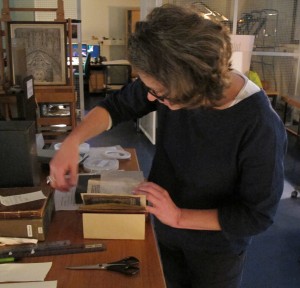Displaying incunabula: a labour of love
The Library’s incunabula exhibition, Private Lives of Print: the use and abuse of books 1450-1550 opened to great acclaim on 23 October 2014. Thanks to a generous donation from the Howard and Abby Milstein Fund we are able to photograph every item in the cases for a virtual exhibition which will remain after the physical display closes. Given the short exhibition changeover period (only eight working days in this instance) the books were photographed in advance, many of them flat or as single pages, rather than in their final cradles.
There has been a great deal of interest from other specialist librarians and exhibition curators in the way we have displayed the books. The process of preparation for this particular exhibition was considerably more intensive than in previous cases; the theme of the exhibition focuses primarily on books as objects, rather than on the texts within, meaning that they need to be displayed in unusual and often unique ways. The Library’s Conservation team leapt at the challenges this created: how to show multiple openings at once; how to hang broadsides as if nailed to the back of the case; how to display a binding and its endpapers simultaneously. Some of the stands took several months to design, and were manufactured by Engineering Design and Plastics, a local firm. Other special features of the display, such as the maniculae pointing at marginal markings in our Gutenberg Bible, were dreamed up only in the last few days of the mounting process and created with a Blue Peter-esque level of ingenuity. The curators and exhibitions officers are immensely grateful to the Conservation team for their patience, imagination and dedication to this exhibition, and a few samples of their work are shown here. Some of the photographs were taken professionally at the exhibition opening, others by a member of staff, so please excuse the variation in quality. Continue reading 'Displaying incunabula: a labour of love'»
